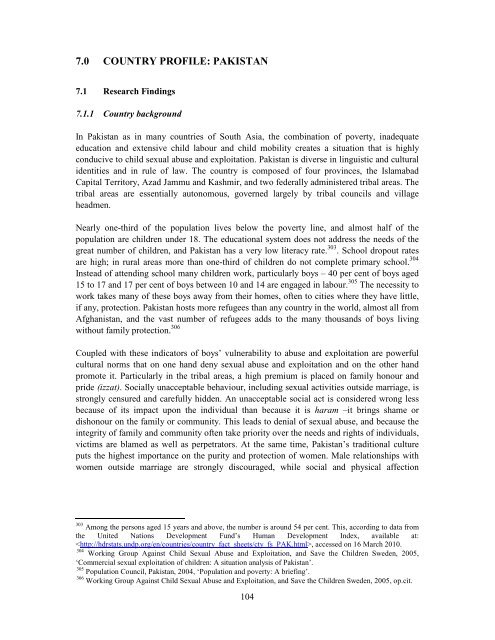SEXUAL ABUSE AND EXPLOITATION OF BOYS IN SOUTH ASIA A ...
SEXUAL ABUSE AND EXPLOITATION OF BOYS IN SOUTH ASIA A ...
SEXUAL ABUSE AND EXPLOITATION OF BOYS IN SOUTH ASIA A ...
Create successful ePaper yourself
Turn your PDF publications into a flip-book with our unique Google optimized e-Paper software.
7.0 COUNTRY PR<strong>OF</strong>ILE: PAKISTAN<br />
7.1 Research Findings<br />
7.1.1 Country background<br />
In Pakistan as in many countries of South Asia, the combination of poverty, inadequate<br />
education and extensive child labour and child mobility creates a situation that is highly<br />
conducive to child sexual abuse and exploitation. Pakistan is diverse in linguistic and cultural<br />
identities and in rule of law. The country is composed of four provinces, the Islamabad<br />
Capital Territory, Azad Jammu and Kashmir, and two federally administered tribal areas. The<br />
tribal areas are essentially autonomous, governed largely by tribal councils and village<br />
headmen.<br />
Nearly one-third of the population lives below the poverty line, and almost half of the<br />
population are children under 18. The educational system does not address the needs of the<br />
great number of children, and Pakistan has a very low literacy rate. 303 . School dropout rates<br />
are high; in rural areas more than one-third of children do not complete primary school. 304<br />
Instead of attending school many children work, particularly boys – 40 per cent of boys aged<br />
15 to 17 and 17 per cent of boys between 10 and 14 are engaged in labour. 305 The necessity to<br />
work takes many of these boys away from their homes, often to cities where they have little,<br />
if any, protection. Pakistan hosts more refugees than any country in the world, almost all from<br />
Afghanistan, and the vast number of refugees adds to the many thousands of boys living<br />
without family protection. 306<br />
Coupled with these indicators of boys’ vulnerability to abuse and exploitation are powerful<br />
cultural norms that on one hand deny sexual abuse and exploitation and on the other hand<br />
promote it. Particularly in the tribal areas, a high premium is placed on family honour and<br />
pride (izzat). Socially unacceptable behaviour, including sexual activities outside marriage, is<br />
strongly censured and carefully hidden. An unacceptable social act is considered wrong less<br />
because of its impact upon the individual than because it is haram –it brings shame or<br />
dishonour on the family or community. This leads to denial of sexual abuse, and because the<br />
integrity of family and community often take priority over the needs and rights of individuals,<br />
victims are blamed as well as perpetrators. At the same time, Pakistan’s traditional culture<br />
puts the highest importance on the purity and protection of women. Male relationships with<br />
women outside marriage are strongly discouraged, while social and physical affection<br />
303 Among the persons aged 15 years and above, the number is around 54 per cent. This, according to data from<br />
the United Nations Development Fund’s Human Development Index, available at:<br />
, accessed on 16 March 2010.<br />
304 Working Group Against Child Sexual Abuse and Exploitation, and Save the Children Sweden, 2005,<br />
‘Commercial sexual exploitation of children: A situation analysis of Pakistan’.<br />
305 Population Council, Pakistan, 2004, ‘Population and poverty: A briefing’.<br />
306 Working Group Against Child Sexual Abuse and Exploitation, and Save the Children Sweden, 2005, op.cit.<br />
104










